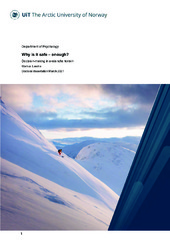| dc.contributor.advisor | Pfuhl, Gerit | |
| dc.contributor.author | Landrø, Markus | |
| dc.date.accessioned | 2021-10-01T10:28:04Z | |
| dc.date.available | 2021-10-01T10:28:04Z | |
| dc.date.issued | 2021-10-25 | |
| dc.description.abstract | The snowy mountains of the world attract an increasing number of backcountry recreationalists, but nice skiing comes with a risk. Every year about 140 people in Europe and North America lose their life in avalanche accidents. 9 out of 10 accidents are triggered by the victim or someone in their party. Therefore, improving decision-making is important. Avalanche terrain decision-making is complex and involves considering a range of potential factors. The assessment of these factors is associated with varying degrees of uncertainty, and uncertainty characterizes the decision-making environment. This thesis aimed to gather more insight into the foundation in avalanche decision-making to improve decision quality. In five separate studies, decision basis, decision competence, and the decision process, three aspects of importance for decision quality are studied. In this thesis's first study, existing decision-making frameworks are investigated, providing the first-ever comprehensive review of the underlying factors. This study also described each method's structure and the ideas behind the overall approach to the decision-making process. The second study revealed a large difference in the number of factors, structure, and overall approach to decision-making between existing frameworks and expert decision-making. In the third study, the understanding of avalanche risk factors among backcountry recreationalists was investigated. The results demonstrated that a factor's relevance did not depend on avalanche education, but so did how precisely the factor could be assessed. This suggests that even non-experts could apply analytical, knowledge-based decision-making given they are provided the proper education. The avalanche forecast is an important source of information when planning a trip in avalanche terrain. Results in the fourth study showed that recreationalists understanding of the avalanche forecast aligned with expert's understanding and confirms the importance of the forecast to the end-users. In the fifth and final study in this thesis, frame selection on risk perception and how it affects behaviour intentions was investigated. The study demonstrates that risk judgments framed in terms of safety (How safe is this decent?) result in more cautious, conservative judgments than when framed in terms of danger (How dangerous is this decent?). | en_US |
| dc.description.doctoraltype | ph.d. | en_US |
| dc.description.popularabstract | Few things are as beautiful as snow-covered mountains. Along with this beauty comes a threat – the threat of avalanches. 9 out of 10 avalanche accidents are triggered by the victim or someone in their party. Thus, how backcountry recreationalists make a decision is of major importance. In this thesis, all relevant factors that a recreationalist may consider are reviewed and discussed along with the existing decision-making frameworks. Further, results suggesting that other user groups could apply expert strategies given the right education are presented, and the importance of avalanche forecasts is confirmed. Decision-making in avalanche terrain is associated with uncertainty. How you approach decision-making is of importance. Is it safe until proven unsafe, or unsafe until proven safe? This makes a difference. People asking how safe a slope is less willing to take risk than to people who ask how dangerous a slope is. | en_US |
| dc.description.sponsorship | Norges vassdrags- og energidirektorat (NVE)
UiT Norges arktiske universitet | en_US |
| dc.identifier.uri | https://hdl.handle.net/10037/22697 | |
| dc.language.iso | eng | en_US |
| dc.publisher | UiT The Arctic University of Norway | en_US |
| dc.publisher | UiT Norges arktiske universitet | en_US |
| dc.relation.haspart | <p>Paper I: Landrø, M., Pfuhl, G., Engeset, R., Jackson, M. & Hetland, A. (2020). Avalanche decision-making frameworks: Classification and description of underlying factors. <i>Cold Regions Science and Technology, 169</i>, 102903. Also available in Munin at <a href=https://hdl.handle.net/10037/16900>https://hdl.handle.net/10037/16900</a>.
<p>Paper II: Landrø, M., Hetland, A., Engeset, R. & Pfuhl, G. (2020). Avalanche decision-making frameworks: Factors and methods used by experts. <i>Cold Regions Science and Technology, 170</i>, 102897. Also available in Munin at <a href=https://hdl.handle.net/10037/16817>https://hdl.handle.net/10037/16817</a>.
<p>Paper III: Landrø, M., Engeset, R. & Pfuhl, G. (2020). The role of avalanche education in assessing and judging avalanche risk factors. (Submitted manuscript).
<p>Paper IV: Engeset, R.V., Pfuhl, G., Landrø, M., Mannberg, A. & Hetland, A. (2018). Communicating public avalanche warnings – what works? <i>Natural Hazards and Earth System Sciences, 18</i>(9), 2537-2559. Also available in Munin at <a href=https://hdl.handle.net/10037/14034>https://hdl.handle.net/10037/14034</a>.
<p>Paper V: Stephensen, M., Schulze, C., Landrø, M., Hendrikx, J. & Hetland, A. (2020). Should I Judge Safety or Danger? Perceived Risk Depends on the Question Frame. <i>Journal of Experimental Psychology: Applied, 27</i>(3), 485-502. Also available at <a href=http://dx.doi.org/10.1037/xap0000354>http://dx.doi.org/10.1037/xap0000354</a>. | en_US |
| dc.rights.accessRights | openAccess | en_US |
| dc.rights.holder | Copyright 2021 The Author(s) | |
| dc.rights.uri | https://creativecommons.org/licenses/by-nc-sa/4.0 | en_US |
| dc.rights | Attribution-NonCommercial-ShareAlike 4.0 International (CC BY-NC-SA 4.0) | en_US |
| dc.subject | VDP::Samfunnsvitenskap: 200::Psykologi: 260 | en_US |
| dc.subject | VDP::Social science: 200::Psychology: 260 | en_US |
| dc.title | Why is it safe – enough? Decision-making in avalanche terrain | en_US |
| dc.type | Doctoral thesis | en_US |
| dc.type | Doktorgradsavhandling | en_US |


 English
English norsk
norsk
